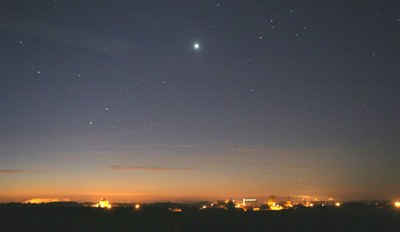Observing and photographing Venus
Observe Venus
Venus with the naked eye
Venus is easy to find because it is the brightest celestial body in the sky after the Sun and the Moon.
Some observers say that they are able to see its crescent when Venus is close to the Earth, around the inferior conjunction. Its apparent diameter is about 1' (1/60 °); this is the limit of the resolution of the human eye, so it's theoretically possible if you are hawk-eyed. You can attempt this in the evening in May 2012, or in the morning at the end of June or July 2012.
Venus through binoculars
One can guess the crescent shape of Venus through a pair of binoculars on condition it is observed when it is in crescent or in quarter, between the maximum elongation and the inferior conjunction (that is to say between late March and late May in the evening or between late June and end of August in the morning).
Venus through a refracting telescope or a reflecting telescope
This is the best way to be sure you see the phases of Venus (even through a small optical instrument).
In the evening:
- In February, Venus is gibbous, it almost appears as a disk and it is difficult to distinguish its shape.
- In March, it begins to assume the form of a recognizable quarter.
- In April and May, it’s easy to observe its crescent.
In the morning, the phases are reversed. Venus is a crescent from late June to mid-August and then gibbous until the end of the year.
Photograph Venus
With a normal camera lens
It is easy to photograph a landscape with Venus in it in the evening, before it gets totally dark (until the end of May) or in the morning when the day dawns (from late June). Settings can be left on automatic.

(automatic settings)

Venus in the morning (exposure time : 15 s)
With a telephoto lens
At the end of May, in the evening, or late in June, in the morning, the crescent of Venus will measure nearly 1’ in its greatest dimension (and less than 10" wide).
With a telephoto lens of 300 mm focal length, which gives a 10 to 20 pixels picture, depending on the camera sensor, the crescent will be small but still visible.
With a telescope
Here are three ways to photograph the crescent of Venus. In each case, it is essential to carry out tests.
- 1. Instrument + ocular + compact digital camera fixed behind the ocular. You can buy a system for attaching the unit behind the ocular or make your own.

Compact digital camera mounted behind a refracting telescope without ocular
- 2. Instrument without ocular + webcam without lens (possibly with a Barlow lens). Again, you can buy a system that enables you to attach the webcam to the eyepiece holder.


- 3. Instrument without ocular + digital reflex camera without lens (possibly with a Barlow lens).

Document Actions

